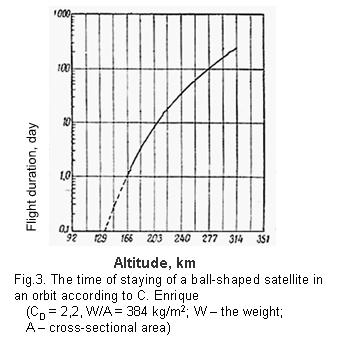
4. Prospects of broad using of little-budgetary satellites for low-orbiting multipurpose groupings
It is well known, that the research of the circumterrestrial space is being successfully realized in the near-earth orbit at the altitudes of 200-250 km. There may work manned orbital stations. It is well known too, that the state air limit for many countries comes to an end at the altitudes of 100 km. It may be suggested, that the range of effective long-term use of ASP and aerospace complexes (ASC) with reusable satellites may be at the altitudes of 100-150 km (maneuvering and flight of ASP stages) and at the altitudes more than 300 km (creation and maintenance of the ASC).
As for ASC with satellite groupings, operation of which is possible at the altitudes of 300-400 km, it is necessary to overcome conventional concepts, which have been formed by creators of existing satellites with respect to commercial ones.
As for low orbits, bordering with dense atmosphere, it is necessary to take into account the theory of satelloid, suggested by Craft Enrique, in the middle of the last century, before the first satellites were launched [11]. Here is extract from this theory:
ōFor stabilization of the satellite in an orbit it is required a certain minimal altitude, providing a fixed orbit during a number of cycles (revolutions). Since the satellite is affected by aerodynamic forces, its flight along an orbit is influenced not only by an altitude (i.e. air density, dynamic pressure), but also by drag force factor CD. For the altitudes exceeding 90 000 m, the drag resistance factor is constant, and for a ball-shaped body is equal approximately 2,2ö. C. Enrique suggested, that the altitudes, which are lower, than 180 km (and particularly lower, than 120 km) cannot be efficiently used for satellites, and he concluded with equation for valuation of the time of staying the satellite in a Earth circular orbit (fig.3).
As for the satellite with the diameter 0,5m, according to C. Enrique, the satellite weight must be 75 kg. The duration of flight of such a satellite in a circular orbit without fine-adjustment thrusters will be nearly 5 ¢ 6 months. Such satellites were used for reconnaissance purposes.
Usually the satellites, including ones for earth remote sensing (ERS) and low-orbit communication, are put in low circular orbits with altitudes 700-1500 km. Reduction of altitudes for, e.g., ERS, from the altitude 900 km to 300 km increases the resolution capability of the same apparatus 9 times as large. Therefore, the apparatus for ERS with low resolution capability (hence cheaper and lighter in weight, than that with high resolution capability) can give high resolution due to orbit reduction.
As an option, there can be considered the satellite, flying along elliptical orbit at the altitudes, e.g., 300-1500 km. In this case the life of the satellite is increased, but the period of a surface surveying at the minimal altitude is decreased.
Another option is possible, if using little-budgetary satellites with simplified construction with periodical transfer to higher orbit by the orbital plane. The ASP ōSuraö is intended for this option.
Bibliography.
1. Kukushkin V. I., Levenko A. S. Aerospace plane. The time of search and accomplishments. - D.: Prospect, 2007. ¢ 200 p.
2. Method of flight of the reusable aerospace aircraft to the Earth orbit and reusable aerospace aircraft for realization of this method. The patent on the invention # UA 844 79 C2 of 27.10.2008.
3. Aerospace plane. Patent on useful model # UA 18699 U of 15.11.2006.
4. Called by time. From the opposition to international collaboration / Under the editorship of S. N. Konyuhov. - D.: ART-PRESS, 2004. - 768 p.
5. Levenko A. S. Aerospace complex. Substantiation and project specifications: Aerospace complex ōBlack Seaö, two-stage reusable aerospace plane ōSuraö / Edited by V. I. Kukushkin. - D.: Prospect, 2007. - 90 p.
6. Method of separation from the launch vehicle with simultaneous provision of the cable system of gravitational orientation along local vertical and stabilizing angular position of the satellite in the orbit, which is being transformed for reusable application. The patent on useful model # UA 34218 U of 11.08.2008.
7. Pirozhenko A. V., Chramov D. A. Analysis of frequencies of oscillations of the space cable systems with spherical joint // Technical mechanics, 2004, #1. ¢ P. 110-118.
8. Andriyenko A. Y., Chadayev A. I. Analysis of possibilities of intensely-gravitational stabilization of low-orbital satellites // Space exploration, 1998, V. 36, # 4 ¢ P. 391-398.
9. Ohotsimsky D. E., Sarychev V. A. Gravitational stabilization system of artificial satellites // Artificial satellites of the Earth, # 16 ¢ M.: Publication of Academy of Sciences of the USSR, 1963. ¢ P. 5-9.
10. Aerospace complex on the basis of aerospace plane. The patent on the useful model # UA 29069 U of 10.01.2008.
11. C. Enrique, Aero Digest, 73, 1956, # 1. ¢ P. 46-54 (Internet-publication ōGravitational stabilizationö http://dynal15.narod.ru/gs.htm).
EXIT
|